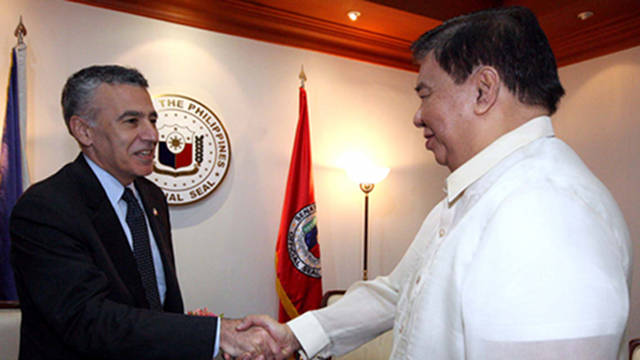SUMMARY
This is AI generated summarization, which may have errors. For context, always refer to the full article.

MANILA, Philippines – The administration is looking at the United States’ disaster response agency for lessons in creating a “permanent structure” for the Philippines.
Senate President Franklin Drilon said this was one of the topics he discussed with US Ambassador to Manila Philip Goldberg, who paid him a courtesy call at the Senate on Thursday, December 5.
Drilon and Goldberg discussed rehabilitation efforts in the aftermath of Super Typhoon Yolanda (Haiyan), the world’s most powerful typhoon that killed 5,759 as of Thursday, left thousands homeless, and flattened towns and cities in Eastern Visayas.
The Senate President said the government needs a more “permanent” body than the “ad hoc” National Disaster Risk Reduction and Management Council (NDRRMC), which is under the Department of National Defense. (READ: Urgently needed, a new disaster agency)
“We discussed the bureaucracy at the federal level of the US government, how they responded to disasters such as this. They had (Hurricane) Katrina and (superstorm) Sandy. In our case, we still have an ad hoc council that handles relief and rehabilitation. We are looking at the possibility of having a permanent government structure instead of what we have today.”
Drilon said the Philippines is looking at the structure of the US Federal Emergency Management Agency (FEMA), which is under the US Department of Homeland Security. FEMA coordinates efforts to prepare for, protect against, respond to, recover from, and mitigate all hazards.
Following Hurricane Katrina in 2005, FEMA also drew criticism for “confusion over the roles and responsibilities of officials” and lawmakers proposed that it be a Cabinet-level organization.
“I understand that a lot of improvement happened after Katrina and we’re looking at that to see the good practices we can adopt here so we’ll be able to respond effectively to disasters that will visit us in the future,” Drilon said.
Drilon said the lack of a permanent structure prompted President Benigno Aquino III to appoint Yolanda rehabilitation czar former Senator Panfilo Lacson.
Senators have pointed out though that Lacson will not be able to handle rehabilitation funds because the money is allotted for line agencies or departments. Senator Francis Escudero has said Lacson’s job seems to be limited to coordination.
Lacson’s job description and the structure of his office have yet to be known, pending an executive order.
Drilon’s statement comes after Senators Grace Poe and Alan Peter Cayetano filed bills and resolutions calling for the creation of a separate department for disaster response and mitigation to replace the NDRRMC.
Poe and Cayetano want the head of the new body to be a Cabinet secretary focused solely on disaster risk reduction and management.
“When the disaster reaches a certain level of devastation, we need one agency for rehabilitation and reconstruction or redevelopment authority or commission or corporation in charge, accountable and focused on this,” Cayetano said in a radio interview on Thursday.
Senator Nancy Binay has also called for a Senate investigation on the government’s “slow and disorganized” response to Yolanda.
‘Study World War II recovery program’
In line with the rehabilitation work, Poe filed a resolution calling on the Senate to study the European Recovery Program (ERP) after World War II.
In Senate Resolution 402, Poe said the chamber must look into the possibility of adopting the plan or parts of it for the rehabilitation of Yolanda-devastated areas. Poe based the idea on a newspaper commentary of Rolando Valenzuela who worked for state weather bureau PAGASA and the US Agency for International Development (USAID).
The ERP, more commonly known as the Marshall Plan, was an American-led initiative aimed to rebuild the economies of Western Europe, restore political stability, and blunt communism after the second world war. Sixteen nations were part of the program, working with the Economic Cooperation Administration (ECA) of the United States.
The plan was named after then US Secretary of State George Marshall.
“The Marshall Plan focused not only on bringing back what was lost but even improving the pre-war conditions, through efforts of modernization, utilization of high-efficiency models, reducing trade barriers, and instilling a sense of hope and self-reliance,” Poe said in her resolution.
Poe said the following are points of the Marshall Plan that can be applied to the post-Yolanda rehabilitation:
- One “central administration” – the Economic Cooperation Administration (ECA) – supervised the entire plan.
- The Marshall Plan funds were transferred to the countries devastated by World War II.
- The Marshall Plan funds were jointly administered by the local governments affected and the ECA.
- Each European capital had an ECA envoy, generally a prominent American businessman, who would advise on the process.
- The cooperative allocation of funds was encouraged, and panels of government, business, and labor leaders were convened to examine the economy and see where aid was needed.
- Some Marshall Plan funds were lent to private entities as long as said entities utilize said funds for the rehabilitation.
Poe noted that the Marshall Plan led to “unprecedented growth and prosperity” in Western Europe.
What do you think of the senators’ proposals? Let us know in the comments section below. – Rappler.com
Add a comment
How does this make you feel?
There are no comments yet. Add your comment to start the conversation.